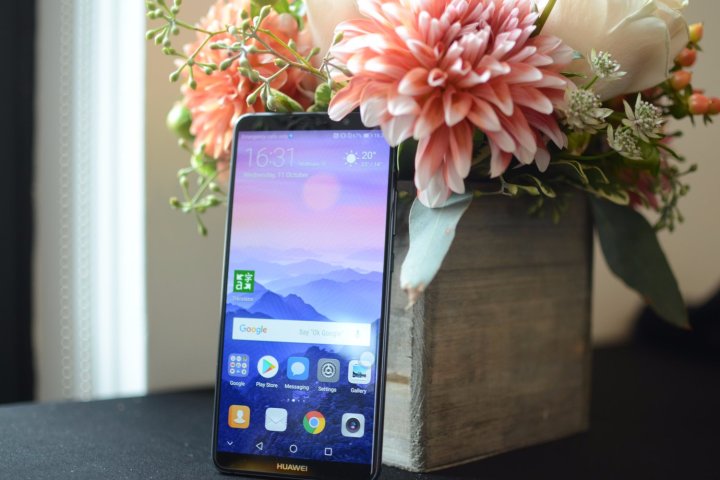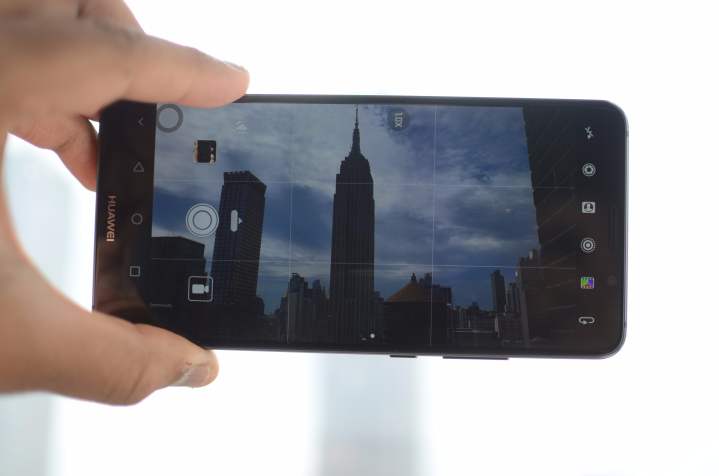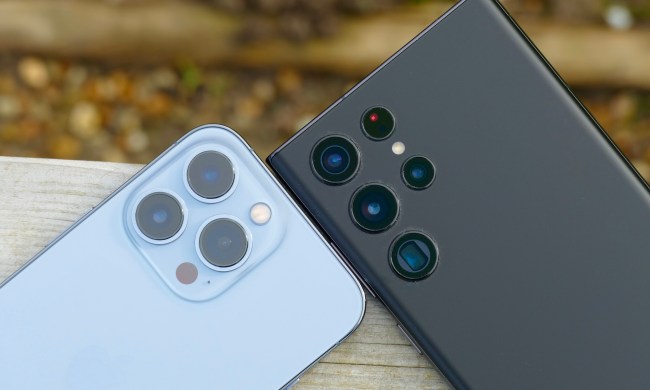
But Apple isn’t going to take that lying down. The iPhone X release is on the horizon, and it cuts an intimidating figure. A 5.8-inch bezel-less design is underpinned with the latest and most powerful technology available. The landscape of the smartphone world is likely to change heavily come November, but where do the Mate 10 Pro and the iPhone X stand at the moment? We’ve put together a brief breakdown of what we know, divided into categories to find out which of the two phones we expect to be the stronger come their release.
Specs
| Huawei Mate 10 Pro
|
iPhone X
|
|
| Size | 154.2 x 74.5 x 7.9 mm (6.07 x 2.93 x 0.31 inches) | 143.6 x 70.9 x 7.7 mm (5.65 x 2.79 x 0.30 inches) |
| Weight | 178 grams (6.28 ounces) | 174 grams (6.14 ounces) |
| Screen | 6-inch AMOLED | 5.8-inch Super Retina AMOLED display |
| Resolution | 2160 x 1080 (402 ppi) | 2436 x 1125 pixels (458 ppi) |
| OS | Android 8.0 Oreo | iOS 11 |
| Storage | 64GB, 128GB | 64GB, 256GB |
| MicroSD card slot | No | No |
| NFC support | Yes | Yes (Apple Pay only) |
| Processor | Huawei Kirin 970 | A11 Bionic with 64-bit architecture, M11 motion co-processor |
| RAM | 4GB, 6GB | 3GB |
| Connectivity | LTE (Cat 18), GSM, CDMA, HSPA, EVDO, 802.11a/b/g/n/ac Wi-Fi | 4G LTE, GSM, CDMA, HSPA+, 802.11a/b/g/n/ac Wi-Fi |
| Camera | Dual 20-megapixel monochrome and 12-megapixel RGB rear, 8-megapixel front | Dual 12 MP rear, 7MP FaceTime HD front |
| Video | Up to 4K at 30 fps | Up to 4K at 60 fps, 1080p at 240 fps |
| Bluetooth | Yes, version 4.2 | Yes, version 5.0 |
| Fingerprint sensor | Yes | No, has Face ID instead |
| Other sensors | Accelerometer, barometer, gyro, geomagnetic, proximity | Accelerometer, gyro, proximity, compass, barometer |
| Water resistant | Yes, IP67 rated | Yes, IP67 rated |
| Battery | 4,000mAh
Fast charging |
2,716mAh
21 hours of talk time, 13 hours of internet, 14 hours of video playback, and up to 60 hours of audio playback Fast charging – 50 percent charge in 30 minutes, wireless charging (Qi standard) |
| Charging port | USB-C | Lightning |
| Marketplace | Google Play Store | Apple App Store |
| Colors | Midnight Blue, Titanium Gray, Mocha Brown, Pink Gold | Space Gray, Silver |
| Availability | November | AT&T, Verizon, T-Mobile, Apple |
| Price | Around $945 | $999 |
| DT review | Hands-on | Hands-on |
The Mate 10 Pro will ship with Huawei’s newest proprietary processor, the Kirin 970. We’ve seen good performance from Kirin chips in the past, especially the Kirin 955 in the Huawei P9, and we expect the 970 to perform well. What’s new this time is the addition of a Neural Processing Unit (NPU) that exists purely to drive Huawei’s new AI features. With this additional bit of brain power, the Mate 10 Pro will have extra capacity for apps and processes, and with 4GB of RAM (6GB on the 128GB model), you shouldn’t have any shortage of multitasking capability.
In the other corner, the iPhone X is packing Apple’s latest A11 Bionic processor. This nifty little piece of tech has been shown to dramatically outpace the Snapdragon 835 (the processor inside many of the latest Android flagship phones), and while we’ll have to wait for the benchmarks to come back before we can be totally certain, it’s highly likely that the A11 processor will leave the Kirin 970 in the dust. While the iPhone X is only rocking 3GB of RAM, the way that Android phones and iOS phones handle RAM is completely different, and it’s hard to gauge how this disparity will affect the phones in the real world. But based on past experience, we expect the iPhone to run as smoothly as ever, thanks to the close integration between Apple’s software and hardware.
While neither phone comes with a 3.5mm headphone jack, the iPhone X will be running the latest version of Bluetooth 5, with faster transfer speeds, a steadier connection, and longer range. The Mate 10 Pro has no such upgrade, and is stuck with Bluetooth 4.2 — an odd omission for a flagship smartphone dropping the headphone jack in 2017. Neither the iPhone X or the Mate 10 Pro support expandable storage. Both have 64GB of storage as the base level, but only the iPhone offers a 256GB model for those who love to fill their device with apps — Huawei owners are going to be stuck with 128GB at the most.
While the Huawei Mate 10 Pro is likely to be a powerful flagship with the addition of the new Kirin 970, the pure power of the A11 Bionic processor and the extra optional storage space on the iPhone X are not to be sniffed at, and so Apple takes home the prize.
Winner: iPhone X
Design and display

You’re not going to confuse these two phones, and personal preference is going to play a large part in your choice between the two designs. The Mate 10 Pro is a more balanced, symmetrical affair, with minimal bezels on the sides of the phone, and a slim forehead and chin at the top and bottom of the device. The rear of the device is glass over metal, with a slim reflective strip laid across the twin vertical camera lenses. The fingerprint sensor can also be found here, echoing the rear fingerprint scanner of earlier models. It’s a fairly minimalist design, but still a gorgeous piece of tech — especially the reflective strip.
Like the Mate 10 Pro, the iPhone X is also a blend of glass and metal, but the similarities end there. The front of the device is almost all screen, with a black border framing all sides, only broken up by the distinctive top notch housing the front-facing camera and sensor suite. The rear of the phone shares a vertically stacked camera configuration with the Mate 10 Pro, but lacks any sort of fingerprint sensor — Apple have gone all in on the facial recognition Face ID tech in this smartphone.
The screens are the most prominent and important parts of these phones, and it would be remiss of us not to focus on those now. The Huawei Mate 10 Pro brings a 6-inch AMOLED display with a 2160 x 1080 pixel resolution, resulting in 402 pixels-per-inch (ppi). While it’s not the sharpest display around, it’s still beautifully crisp, and capable of AMOLED’s signature incredible color depth. The iPhone X has a slightly smaller, 5.8-inch Super AMOLED display, but with a higher resolution of 2436 x 1125 pixels (458 ppi), making it the crisper of the two devices, and simply stunning to stare at.
In terms of size, the Mate 10 Pro towers over the relatively diminutive iPhone X, as well as being thicker and wider. Even with the thin bezels, the Mate 10 Pro is still a large phone (though not quite as large as the Note 8), and you’ll struggle to access all of the screen one-handed if you’re possessed of smaller hands. Thanks to the lack of bezels, the iPhone X is more of a standard-sized phone and easier to manage.
On the durability front you’re not likely to be taking either phone white-water rafting. Both come with an IP67 rating, so while you can expect them to handle splashes of water and even a brief dunk, they’re not going to be as water-resistant as the Galaxy Note 8 or the LG V30. As both phones incorporate a lot of glass in their design, we’d recommend a protective case regardless of your choice. We’ll be sure to put both of these phones through their paces when we get a good amount of time with them.
While the Mate 10 Pro is gorgeous and boasts a minimalist design that we love, the iPhone X’s design is nothing short of stunning. The Mate 10 Pro puts up a good fight, matching the iPhone blow-for-blow on many points, but it doesn’t quite manage to beat the iPhone. The iPhone X’s superior screen and pixel-per-inch ratio give it the edge in this category.
Winner: iPhone X
Camera

Regardless of which phone you pick, you’re going to have a vertically-stacked dual camera. Apple have packed two 12-megapixel lenses into the iPhone X — one wide-angle, the other telephoto. If you’re a close follower of Apple, you’ll notice that the X’s cameras have strong similarities to the two in the iPhone 8 Plus — and you’d be right to notice that. With the exception of the iPhone X replacing the f/2.8 aperture on the 8 Plus with a f/2.4 aperture, the cameras are virtually the same. But that’s no bad thing — the iPhone 8 Plus has one of the best smartphone cameras in the world, and the altered aperture should give the iPhone X an even stronger camera in low light conditions. On the other side, the Mate 10 Pro packs a 20-megapixel monochrome camera and a 12-megapixel RGB camera — both Leica-branded, and both with an exceptional f/1.6 aperture. It’s a world first to have both lenses with an aperture this size, and it should boost low light photography and deliver the quality of shot that Huawei’s phones are becoming famous for.
Both cameras will be able to simulate bokeh-style selective focus thanks to the dual-lenses and software, but the iPhone’s Portrait Lighting mode is likely to give the Apple phone an edge when shooting single subjects. However, the extra oomph from the AI-focused Kirin 970 will be able to automatically shift camera settings based on what the camera is looking at — for instance, Huawei’s camera will add extra saturation to food, giving images that extra hint of deliciousness.
For front-facing selfie shots, you’re looking at a 7-megapixel shooter on the iPhone X and an 8-megapixel camera on the Mate 10 Pro — though the newly front-facing Portrait Mode on the iPhone X will likely give Apple the edge in selfies. Video-wise, the iPhone X can shoot 4K video at 60 frames per second — while the Mate 10 Pro can only do so at 30 fps. But how much that matters to you will depend on how much video you actually record.
There’s so much to choose from with these cameras, and both brands have a strong record with smartphone photography. While iPhones have recently had an exceptionally strong camera, we’re eager to see what the Mate 10 Pro can do with the extra legs given to it by the AI-processing granted by the Kirin 970 NPU. For that reason, we have to score this round a draw, at least until we test them both out a bit more extensively.
Battery life and charging

The iPhone X comes with a nonremovable 2,716mAh battery that we expect will last most users between a day and a day and a half. When its time to recharge, Apple’s fast charger should be able to charge up to 50 percent of battery life within 30 minutes — though it remains to be seen whether a fast charger comes with the handset. Thanks to the all-glass back on the X, Qi standard wireless charging is also available.
The Mate 10 Pro also comes with Huawei’s Supercharge technology, and Huawei claims it is capable of charging 50 percent in 30 minutes, equaling Apple’s boast. While the Mate 10 Pro doesn’t support wireless charging, it is hauling a massive 4,000mAh battery that Huawei claim will last two days on moderate usage. A battery of this size is exceptional — the Galaxy Note 8 has a much larger footprint, but is only packing a 3,300mAh battery. Despite the lack of wireless charging, the extra battery size awards Huawei the crown.
Software
You’ll find Apple’s latest iOS 11 on the iPhone X, with an improved App Store, Notifications, and Control Center, as well as a whole host of other improvements. The Mate 10 Pro ships with Huawei’s latest version of Emotion UI, EMUI 8.0. A heavily altered version of Android, EMUI 8.0 is the latest in the EMUI lineup, replacing EMUI 5.0 and scoring up to 8 to match the latest version of Android, Android 8.0 Oreo.
Usually, your choice between Android and iOS would come down to which OS you’ve preferred over the years, but the inclusion of EMUI messes this up a little. While your accumulated Google Play Store apps will still work on the Mate 10 Pro, EMUI could come as a shock to the system. Still, EMUI has improved in leaps-and-bounds over the years, and EMUI 8.0 comes with some significantly cool upgrades, including the AI-focus that aims to make your life easier through prompts and automation, and a new floating home button.
We find it hard to come down firmly in either camp — we believe your choice between iOS and Android is always going to be largely based on personal experience. EMUI adds a lot to the rich Android experience, but iOS 11 is one of the smoothest experiences you’ll find on a handset. Go with your gut. This is tied for us.
Winner: Tie
Pricing and availability

Neither the Mate 10 Pro or the iPhone X are currently available until November. The iPhone X starts at a cool $999 for the 64GB model, and is available from a wide variety of carriers, including AT&T, Verizon, and T-Mobile. No surprises there; everyone wants to get their hands on the latest iPhone. The Mate 10 Pro is likely to be similarly expensive, and while we don’t have a definite U.S. price yet, European sales of the handset are starting at 800 British pounds — so it’s likely that the base model of the Mate 10 Pro will be around $940. That’s one heck of a price tag, and at the moment we still don’t know whether any carriers will be picking the Mate 10 Pro up — though whispers point to AT&T offering the handset eventually.
Despite the high price point, the iPhone X is going to be available everywhere. It takes this final round.
Winner: iPhone X.
Overall winner: iPhone X
Apple’s iPhone X is just too strong. Everything about the iPhone X screams quality, from the materials used, to the crisp and beautiful AMOLED display. Apple is finally shaking up its iPhone design philosophy, and the iPhone X heralds a new era for the Cupertino giants.
With that said, the Mate 10 Pro certainly has its strong points. The camera is likely to be fantastic, the battery life phenomenal, and the extra processing power from the Kirin 970 will make using EMUI 8.0 a pleasure. It’s a great addition to Huawei’s roster, and you won’t be disappointed if you do end up with one. But for our money, the iPhone X is the superior smartphone.





